Status of Growth of Group III-Nitride Heterostructures for Deep Ultraviolet Light-Emitting Diodes
Abstract
:1. Introduction
2. Current Status and Challenges of Group III-Nitride DUV LEDs
- (1)
- The unavailability of low-cost, lattice, thermal expansion coefficient-matched, and transparent substrate material. Bulk AlN single crystals are very expensive, while sapphire, the most commonly used substrate for DUV LEDs, has a large lattice mismatch (13.3%) and large difference of thermal expansion coefficient with AlN (7.5 × 10−6 K−1 for sapphire vs. 4.2 × 10−6 K−1 for AlN), and inferior thermal conductivity.
- (2)
- The low surface mobility of the Al species on the growth surface, which favors a high density of extended defects such as threading dislocations, resulting in low internal quantum efficiency (IQE) of DUV LEDs.
- (3)
- The notorious low p-type conductivity in high Al-molar fraction AlGaN due to the large activation energy of Mg acceptor, which results in poor hole injection and also detrimental electron overflow from the active region.
- (4)
- Low LEE caused by strong total internal reflection and self-absorption.
3. Device Design for Improved Performance of Group III-Nitride DUV LEDs
4. Growth and Optical Properties of Bulk AlN for DUV LEDs
5. High-Temperature Growth of AlN and High Al-Molar Fraction AlGaN by MOCVD
6. Pulsed-Flow Growth of AlN and High Al-Molar Fraction AlGaN
7. Epitaxial Lateral Overgrowth of AlN and High Al-Molar Fraction AlGaN
8. Pseudomorphic Growth of High Al-Molar Fraction AlGaN on AlN
9. AlN/AlGaN Superlattice Buffer
10. Doping Considerations in High Al-Molar Fraction AlGaN
11. Conclusions
Acknowledgments
Author Contributions
Conflicts of Interest
References
- Pernot, C.; Kim, M.; Fukahori, S.; Inazu, T.; Fujita, T.; Nagasawa, Y.; Hirano, A.; Ippommatsu, M.; Iwaya, M.; Kamiyama, S.; et al. Improved efficiency of 255–280 nm AlGaN-based light-emitting diodes. Appl. Phys. Express 2010, 3, 061004. [Google Scholar] [CrossRef]
- Grandusky, J.R.; Gibb, S.R.; Mendrick, M.C.; Moe, C.; Wraback, M.; Schowalter, L.J. High output power from 260 nm pseudomorphic ultraviolet light-emitting diodes with improved thermal performance. Appl. Phys. Express 2011, 4, 082101. [Google Scholar] [CrossRef]
- Grandusky, J.R.; Chen, J.; Gibb, S.R.; Mendrick, M.C.; Moe, C.G.; Rodak, L.; Garrett, G.A.; Wraback, M.; Schowalter, L.J. 270 nm pseudomorphic ultraviolet light-emitting diodes with over 60 mw continuous wave output power. Appl. Phys. Express 2013, 6, 032101. [Google Scholar] [CrossRef]
- Shatalov, M.; Sun, W.; Lunev, A.; Hu, X.; Dobrinsky, A.; Bilenko, Y.; Yang, J.; Shur, M.; Gaska, R.; Moe, C.; et al. AlGaN deep-ultraviolet light-emitting diodes with external quantum efficiency above 10%. Appl. Phys. Express 2012, 5, 082101. [Google Scholar] [CrossRef]
- Inoue, S.-I.; Naoki, T.; Kinoshita, T.; Obata, T.; Yanagi, H. Light extraction enhancement of 265 nm deep-ultraviolet light-emitting diodes with over 90 mw output power via an AlN hybrid nanostructure. Appl. Phys. Lett. 2015, 106, 131104. [Google Scholar] [CrossRef]
- Maeda, N.; Hirayama, H. Realization of high-efficiency deep-UV LEDs using transparent p-AlGaN contact layer. Phys. Stat. Sol. C 2013, 10, 1521–1524. [Google Scholar] [CrossRef]
- Hirayama, H.; Takano, T.; Sakai, J.; Mino, T.; Tsubaki, K.; Maeda, N.; Jo, M.; Kanazawa, Y.; Ohshima, I.; Matsumoto, T. Realization of Over 10% EQE AlGaN Deep-UV LED by Using Transparent p-AlGaN Contact Layer. In Proceedings of the 2016 International Semiconductor Laser Conference (ISLC), 12–15 September 2016; pp. 1–2. [Google Scholar]
- Takano, T.; Mino, T.; Sakai, J.; Noguchi, N.; Tsubaki, K.; Hirayama, H. Deep-ultraviolet light-emitting diodes with external quantum efficiency higher than 20% at 275 nm achieved by improving light-extraction efficiency. Appl. Phys. Express 2017, 10, 031002. [Google Scholar] [CrossRef]
- Kinoshita, T.; Obata, T.; Nagashima, T.; Yanagi, H.; Moody, B.; Mita, S.; Inoue, S.-I.; Kumagai, Y.; Koukitu, A.; Sitar, Z. Performance and reliability of deep-ultraviolet light-emitting diodes fabricated on AlN substrates prepared by hydride vapor phase epitaxy. Appl. Phys. Express 2013, 6, 092103. [Google Scholar] [CrossRef]
- Moe, C.G.; Grandusky, J.R.; Chen, J.; Kitamura, K.; Mendrick, M.C.; Jamil, M.; Toita, M.; Gibb, S.R.; Schowalter, L.J. High-power pseudomorphic mid-ultraviolet light-emitting diodes with improved efficiency and lifetime. Proc. SPIE 2014, 8986, 89861V. [Google Scholar]
- Hwang, S.; Morgan, D.; Kesler, A.; Lachab, M.; Zhang, B.; Heidari, A.; Nazir, H.; Ahmad, I.; Dion, J.; Fareed, Q.; et al. 276 nm substrate-free flip-chip AlGaN light-emitting diodes. Appl. Phys. Express 2011, 4, 032102. [Google Scholar] [CrossRef]
- Fujioka, A.; Misaki, T.; Murayama, T.; Narukawa, Y.; Mukai, T. Improvement in output power of 280-nm deep ultraviolet light-emitting diode by using AlGaN multi quantum wells. Appl. Phys. Express 2010, 3, 041001. [Google Scholar] [CrossRef]
- Kneissl, M.; Kolbe, T.; Chua, C.; Kueller, V.; Lobo, N.; Stellmach, J.; Knauer, A.; Rodriguez, H.; Einfeldt, S.; Yang, Z.; et al. Advances in group III-nitride-based deep UV light-emitting diode technology. Semicon. Sci. Tech. 2011, 26, 014036. [Google Scholar] [CrossRef]
- Kolbe, T.; Mehnke, F.; Guttmann, M.; Kuhn, C.; Rass, J.; Wernicke, T.; Kneissl, M. Improved injection efficiency in 290 nm light emitting diodes with Al(Ga)N electron blocking heterostructure. Appl. Phys. Lett. 2013, 103, 031109. [Google Scholar] [CrossRef]
- Dong, P.; Yan, J.; Wang, J.; Zhang, Y.; Geng, C.; Wei, T.; Cong, P.; Zhang, Y.; Zeng, J.; Tian, Y.; et al. 282-nm AlGaN-based deep ultraviolet light-emitting diodes with improved performance on nano-patterned sapphire substrates. Appl. Phys. Lett. 2013, 102, 241113. [Google Scholar] [CrossRef]
- Fujioka, A.; Asada, K.; Yamada, H.; Ohtsuka, T.; Ogawa, T.; Kosugi, T.; Kishikawa, D.; Mukai, T. High-output-power 255/280/310 nm deep ultraviolet light-emitting diodes and their lifetime characteristics. Semicon. Sci. Tech. 2014, 29, 084005. [Google Scholar] [CrossRef]
- Hirayama, H.; Maeda, N.; Fujikawa, S.; Toyoda, S.; Kamata, N. Recent progress and future prospects of AlGaN-based high-efficiency deep-ultraviolet light-emitting diodes. Jpn. J. Appl. Phys. 2014, 53, 100209. [Google Scholar] [CrossRef]
- Kneissl, M.; Rass, J. III-Nitride Ultraviolet Emitters. In Springer Series in Materials Science; Springer International Publishing: Cham, Switzerland, 2016; Volume 277. [Google Scholar]
- Hirayama, H. Growth techniques of AlN/AlGaN and development of high-efficiency deep-ultraviolet light-emitting diodes. In III-Nitride Ultraviolet Emitters; Springer: Berlin, Germany, 2016; pp. 75–113. [Google Scholar]
- Hirayama, H.; Fujikawa, S.; Kamata, N. Recent progress in ALGaN-based deep-UV LEDs. Electron. Commun. Jpn. 2015, 98, 1–8. [Google Scholar] [CrossRef]
- Yasan, A.; McClintock, R.; Mayes, K.; Shiell, D.; Gautero, L.; Darvish, S.R.; Kung, P.; Razeghi, M. 4.5 mw operation of AlGaN-based 267 nm deep-ultraviolet light-emitting diodes. Appl. Phys. Lett. 2003, 83, 4701–4703. [Google Scholar] [CrossRef]
- Shatalov, M.; Chitnis, A.; Yadav, P.; Hasan, M.F.; Khan, J.; Adivarahan, V.; Maruska, H.P.; Sun, W.H.; Khan, M.A. Thermal analysis of flip-chip packaged 280 nm nitride-based deep ultraviolet light-emitting diodes. Appl. Phys. Lett. 2005, 86, 201109. [Google Scholar] [CrossRef]
- Ryu, H.-Y.; Choi, I.-G.; Choi, H.-S.; Shim, J.-I. Investigation of light extraction efficiency in AlGaN deep-ultraviolet light-emitting diodes. Appl. Phys. Express 2013, 6, 062101. [Google Scholar] [CrossRef]
- Inoue, S.-I.; Tamari, N.; Taniguchi, M. 150 mw deep-ultraviolet light-emitting diodes with large-area AlN nanophotonic light-extraction structure emitting at 265 nm. Appl. Phys. Lett. 2017, 110, 141106. [Google Scholar] [CrossRef]
- Kim, D.Y.; Park, J.H.; Lee, J.W.; Hwang, S.; Oh, S.J.; Kim, J.; Sone, C.; Schubert, E.F.; Kim, J.K. Overcoming the fundamental light-extraction efficiency limitations of deep ultraviolet light-emitting diodes by utilizing transverse-magnetic-dominant emission. Light Sci. Appl. 2015, 4, e263. [Google Scholar] [CrossRef]
- Lee, J.W.; Kim, D.Y.; Park, J.H.; Schubert, E.F.; Kim, J.; Lee, J.; Kim, Y.I.; Park, Y.; Kim, J.K. An elegant route to overcome fundamentally-limited light extraction in AlGaN deep-ultraviolet light-emitting diodes: Preferential outcoupling of strong in-plane emission. Sci. Rep. 2016, 6, 22537. [Google Scholar] [CrossRef] [PubMed]
- Ichikawa, M.E.S.; Sagawa, H.; Fujioka, A.; Kosugi, T.; Mukai, T.; Uomoto, M.; Shimatsu, T. High output power deep ultraviolet light-emitting diodes with hemispherical lenses fabricated using room temperature bonding. ECS Trans. 2016, 75, 53–65. [Google Scholar] [CrossRef]
- Nagai, S.; Yamada, K.; Hirano, A.; Ippommatsu, M.; Ito, M.; Morishima, N.; Aosaki, K.; Honda, Y.; Amano, H.; Akasaki, I. Development of highly durable deep-ultraviolet AlGaN-based led multichip array with hemispherical encapsulated structures using a selected resin through a detailed feasibility study. Jpn. J. Appl. Phys. 2016, 55, 082101. [Google Scholar] [CrossRef]
- Yamada, K.; Furusawa, Y.; Nagai, S.; Hirano, A.; Ippommatsu, M.; Aosaki, K.; Morishima, N.; Amano, H.; Akasaki, I. Development of underfilling and encapsulation for deep-ultraviolet LEDs. Appl. Phys. Express 2015, 8, 012101. [Google Scholar] [CrossRef]
- Hirano, A.; Nagasawa, Y.; Ippommatsu, M.; Aosaki, K.; Honda, Y.; Amano, H.; Akasaki, I. Development of AlGaN-based deep-ultraviolet (DUV) LEDs focusing on the fluorine resin encapsulation and the prospect of the practical applications. Proc. SPIE 2016, 9926, 99260C. [Google Scholar]
- Fujito, K.; Kubo, S.; Nagaoka, H.; Mochizuki, T.; Namita, H.; Nagao, S. Bulk GaN crystals grown by HVPE. J. Cryst. Growth 2009, 311, 3011–3014. [Google Scholar] [CrossRef]
- Dwiliński, R.; Doradziński, R.; Garczyński, J.; Sierzputowski, L.; Kucharski, R.; Zając, M.; Rudziński, M.; Kudrawiec, R.; Strupiński, W.; Misiewicz, J. Ammonothermal GaN substrates: Growth accomplishments and applications. Phys. Stat. Sol. A 2011, 208, 1489–1493. [Google Scholar] [CrossRef]
- Levinshtein, M.E.; Rumyantsev, S.L.; Shur, M.S. Properties of Advanced Semiconductor Materials: GaN, AlN, InN, BN, SiC, SiGe; John Wiley & Sons: Hoboken, NJ, USA, 2001. [Google Scholar]
- Morkoç, H. Handbook of Nitride Semiconductors and Devices, Materials Properties, Physics and Growth; John Wiley & Sons: Hoboken, NJ, USA, 2009; Volume 1. [Google Scholar]
- Mueller, S.G.; Bondokov, R.T.; Morgan, K.E.; Slack, G.A.; Schujman, S.B.; Grandusky, J.; Smart, J.A.; Schowalter, L.J. The progress of AlN bulk growth and epitaxy for electronic applications. Phys. Stat. Sol. A 2009, 206, 1153–1159. [Google Scholar] [CrossRef]
- Ehrentraut, D.; Sitar, Z. Advances in bulk crystal growth of AlN and GaN. MRS Bull. 2009, 34, 259–265. [Google Scholar] [CrossRef]
- Herro, Z.G.; Zhuang, D.; Schlesser, R.; Collazo, R.; Sitar, Z. Seeded growth of AlN on N- and Al-polar AlN seeds by physical vapor transport. J. Cryst. Growth 2006, 286, 205–208. [Google Scholar] [CrossRef]
- Helava, H.; Chemekova, T.J.; Avdeev, O.; Mokhov, E.; Nagalyuk, S.; Makarov, Y.; Ramm, M. AlN substrates and epitaxy results. Phys. Stat. Sol. C 2010, 7, 2115–2117. [Google Scholar] [CrossRef]
- Herro, Z.G.; Zhuang, D.; Schlesser, R.; Sitar, Z. Growth of AlN single crystalline boules. J. Cryst. Growth 2010, 312, 2519–2521. [Google Scholar] [CrossRef]
- Nagai, I.; Kato, T.; Miura, T.; Kamata, H.; Naoe, K.; Sanada, K.; Okumura, H. AlN bulk single crystal growth on 6H-SiC substrates by sublimation method. J. Cryst. Growth 2010, 312, 2699–2704. [Google Scholar] [CrossRef]
- Makarov, Y.N.; Avdeev, O.V.; Barash, I.S.; Bazarevskiy, D.S.; Chemekova, T.Y.; Mokhov, E.N.; Nagalyuk, S.S.; Roenkov, A.D.; Segal, A.S.; Vodakov, Y.A.; et al. Experimental and theoretical analysis of sublimation growth of AlN bulk crystals. J. Cryst. Growth 2008, 310, 881–886. [Google Scholar] [CrossRef]
- Hartmann, C.; Dittmar, A.; Wollweber, J.; Bickermann, M. Bulk AlN growth by physical vapour transport. Semicon. Sci. Tech. 2014, 29, 084002. [Google Scholar] [CrossRef]
- Ren, Z.; Sun, Q.; Kwon, S.Y.; Han, J.; Davitt, K.; Song, Y.K.; Nurmikko, A.V.; Liu, W.; Smart, J.; Schowalter, L. AlGaN deep ultraviolet LEDs on bulk AlN substrates. Phys. Stat. Sol. C 2007, 4, 2482–2485. [Google Scholar] [CrossRef]
- Collazo, R.; Mita, S.; Xie, J.; Rice, A.; Tweedie, J.; Dalmau, R.; Sitar, Z. Progress on n-type doping of AlGaN alloys on AlN single crystal substrates for UV optoelectronic applications. Phys. Stat. Sol. C 2011, 8, 2031–2033. [Google Scholar] [CrossRef]
- Grandusky, J.R.; Gibb, S.R.; Mendrick, M.C.; Schowalter, L.J. Properties of mid-ultraviolet light emitting diodes fabricated from pseudomorphic layers on bulk aluminum nitride substrates. Appl. Phys. Express 2010, 3, 072103. [Google Scholar] [CrossRef]
- Bryan, Z.; Bryan, I.; Xie, J.; Mita, S.; Sitar, Z.; Collazo, R. High internal quantum efficiency in AlGaN multiple quantum wells grown on bulk AlN substrates. Appl. Phys. Lett. 2015, 106, 142107. [Google Scholar] [CrossRef]
- Bickermann, M.; Epelbaum, B.M.; Filip, O.; Heimann, P.; Nagata, S.; Winnacker, A. UV transparent single-crystalline bulk AlN substrates. Phys. Stat. Sol. C 2010, 7, 21–24. [Google Scholar] [CrossRef]
- Bickermann, M.; Epelbaum, B.M.; Filip, O.; Tautz, B.; Heimann, P.; Winnacker, A. Faceting in AlN bulk crystal growth and its impact on optical properties of the crystals. Phys. Stat. Sol. C 2012, 9, 449–452. [Google Scholar] [CrossRef]
- Tuomisto, F.; Mäki, J.M.; Chemekova, T.Y.; Makarov, Y.N.; Avdeev, O.V.; Mokhov, E.N.; Segal, A.S.; Ramm, M.G.; Davis, S.; Huminic, G.; et al. Characterization of bulk AlN crystals with positron annihilation spectroscopy. J. Cryst. Growth 2008, 310, 3998–4001. [Google Scholar] [CrossRef]
- Sumathi, R.R.; Gille, P. Development and progress in bulk c-plane AlN single-crystalline template growth for large-area native seeds. Jpn. J. Appl. Phys. 2013, 52, 08JA02. [Google Scholar] [CrossRef]
- Collazo, R.; Xie, J.; Gaddy, B.E.; Bryan, Z.; Kirste, R.; Hoffmann, M.; Dalmau, R.; Moody, B.; Kumagai, Y.; Nagashima, T.; et al. On the origin of the 265 nm absorption band in AlN bulk crystals. Appl. Phys. Lett. 2012, 100, 191914. [Google Scholar] [CrossRef]
- Hartmann, C.; Wollweber, J.; Dittmar, A.; Irmscher, K.; Kwasniewski, A.; Langhans, F.; Neugut, T.; Bickermann, M. Preparation of bulk AlN seeds by spontaneous nucleation of freestanding crystals. Jpn. J. Appl. Phys. 2013, 52, 08JA06. [Google Scholar] [CrossRef]
- Sedhain, A.; Du, L.; Edgar, J.H.; Lin, J.Y.; Jiang, H.X. The origin of 2.78 ev emission and yellow coloration in bulk AlN substrates. Appl. Phys. Lett. 2009, 95, 262104. [Google Scholar] [CrossRef]
- Kumagai, Y.; Enatsu, Y.; Ishizuki, M.; Kubota, Y.; Tajima, J.; Nagashima, T.; Murakami, H.; Takada, K.; Koukitu, A. Investigation of void formation beneath thin AlN layers by decomposition of sapphire substrates for self-separation of thick AlN layers grown by HVPE. J. Cryst. Growth 2010, 312, 2530–2536. [Google Scholar] [CrossRef]
- Kumagai, Y.; Nagashima, T.; Koukitu, A. Preparation of a freestanding AlN substrate by hydride vapor phase epitaxy at 1230 c using (111) Si as a starting substrate. Jpn. J. Appl. Phys. 2007, 46, L389. [Google Scholar] [CrossRef]
- Nomura, T.; Okumura, K.; Miyake, H.; Hiramatsu, K.; Eryu, O.; Yamada, Y. AlN homoepitaxial growth on sublimation-AlN substrate by low-pressure HVPE. J. Cryst. Growth 2012, 350, 69–71. [Google Scholar] [CrossRef]
- Kumagai, Y.; Kubota, Y.; Nagashima, T.; Kinoshita, T.; Dalmau, R.; Schlesser, R.; Moody, B.; Xie, J.; Murakami, H.; Koukitu, A.; et al. Preparation of a freestanding AlN substrate from a thick AlN layer grown by hydride vapor phase epitaxy on a bulk AlN substrate prepared by physical vapor transport. Appl. Phys. Express 2012, 5, 055504. [Google Scholar] [CrossRef]
- Kinoshita, T.; Hironaka, K.; Obata, T.; Nagashima, T.; Dalmau, R.; Schlesser, R.; Moody, B.; Xie, J.; Inoue, S.-i.; Kumagai, Y.; et al. Deep-ultraviolet light-emitting diodes fabricated on AlN substrates prepared by hydride vapor phase epitaxy. Appl. Phys. Express 2012, 5, 122101. [Google Scholar] [CrossRef]
- Brunner, F.; Protzmann, H.; Heuken, M.; Knauer, A.; Weyers, M.; Kneissl, M. High-temperature growth of AlN in a production scale 11 × 2’ movpe reactor. Phys. Stat. Sol. C 2008, 5, 1799–1801. [Google Scholar] [CrossRef]
- Chichibu, S.F.; Onuma, T.; Hazu, K.; Uedono, A. Major impacts of point defects and impurities on the carrier recombination dynamics in AlN. Appl. Phys. Lett. 2010, 97, 201904. [Google Scholar] [CrossRef]
- Chichibu, S.F.; Onuma, T.; Hazu, K.; Uedono, A. Time-resolved luminescence studies on AlN and high AlN mole fraction AlGaN alloys. Phys. Stat. Sol. C 2013, 10, 501–506. [Google Scholar] [CrossRef]
- Onuma, T.; Hazu, K.; Uedono, A.; Sota, T.; Chichibu, S.F. Identification of extremely radiative nature of AlN by time-resolved photoluminescence. Appl. Phys. Lett. 2010, 96, 061906. [Google Scholar] [CrossRef]
- Hirayama, H.; Fujikawa, S.; Noguchi, N.; Norimatsu, J.; Takano, T.; Tsubaki, K.; Kamata, N. 222–282 nm AlGaN and in AlGaN-based deep-UV LEDs fabricated on high-quality AlN on sapphire. Phys. Stat. Sol. A 2009, 206, 1176–1182. [Google Scholar] [CrossRef]
- Hirayama, H.; Yatabe, T.; Noguchi, N.; Ohashi, T.; Kamata, N. 231–261nm AlGaN deep-ultraviolet light-emitting diodes fabricated on AlN multilayer buffers grown by ammonia pulse-flow method on sapphire. Appl. Phys. Lett. 2007, 91, 071901. [Google Scholar] [CrossRef]
- Zhang, J.; Kuokstis, E.; Fareed, Q.; Wang, H.; Yang, J.; Simin, G.; Khan, M.A.; Gaska, R.; Shur, M. Pulsed atomic layer epitaxy of quaternary AlInGaN layers. Appl. Phys. Lett. 2001, 79, 925–927. [Google Scholar] [CrossRef]
- Zhang, J.P.; Khan, M.A.; Sun, W.H.; Wang, H.M.; Chen, C.Q.; Fareed, Q.; Kuokstis, E.; Yang, J.W. Pulsed atomic-layer epitaxy of ultrahigh-quality AlxGa1−xN structures for deep ultraviolet emissions below 230 nm. Appl. Phys. Lett. 2002, 81, 4392–4394. [Google Scholar] [CrossRef]
- Bilenko, Y.; Lunev, A.; Hu, X.; Deng, J.; Katona, T.M.; Zhang, J.; Gaska, R.; Shur, M.S.; Sun, W.; Adivarahan, V. 10 milliwatt pulse operation of 265 nm AlGaN light emitting diodes. Jpn. J. Appl. Phys. 2004, 44, L98. [Google Scholar] [CrossRef]
- Sun, W.H.; Yang, J.W.; Zhang, J.P.; Gaevski, M.E.; Chen, C.Q.; Li, J.W.; Gong, Z.; Su, M.; Asif Khan, M. n-Al0.75Ga0.25N epilayers for 250 nm emission ultraviolet light emitting diodes. Phys. Stat. Sol. C 2005, 2, 2083–2086. [Google Scholar] [CrossRef]
- Shatalov, M.; Jain, R.; Saxena, T.; Dobrinsky, A.; Shur, M. Chapter two-development of deep UV LEDs and current problems in material and device technology. Semicond. Semimet. 2017, 96, 45–83. [Google Scholar]
- Hirayama, H.; Yatabe, T.; Noguchi, N.; Ohashi, T.; Kamata, N. 226–273 nm AlGaN deep-ultraviolet light-emitting diodes fabricated on multilayer AlN buffers on sapphire. Phys. Stat. Sol. C 2008, 5, 2969–2971. [Google Scholar] [CrossRef]
- Zhang, J.; Wang, H.; Sun, W.; Adivarahan, V.; Wu, S.; Chitnis, A.; Chen, C.; Shatalov, M.; Kuokstis, E.; Yang, J. High-quality AlGaN layers over pulsed atomic-layer epitaxially grown AlN templates for deep ultraviolet light-emitting diodes. J. Electr. Mater. 2003, 32, 364–370. [Google Scholar] [CrossRef]
- Shur, M.S.; Gaska, R. Deep-ultraviolet light-emitting diodes. IEEE Trans. Electr. Devices 2010, 57, 12–25. [Google Scholar] [CrossRef]
- Kueller, V.; Knauer, A.; Reich, C.; Mogilatenko, A.; Weyers, M.; Stellmach, J.; Wernicke, T.; Kneissl, M.; Yang, Z.; Chua, C.L.; et al. Modulated epitaxial lateral overgrowth of AlN for efficient UV LEDs. IEEE Photonics Technol. Lett. 2012, 24, 1603–1605. [Google Scholar] [CrossRef]
- Liu, C.; Shields, P.A.; Denchitcharoen, S.; Stepanov, S.; Gott, A.; Wang, W.N. Pulsed epitaxial lateral overgrowth of GaN by metalorganic vapour phase epitaxy. J. Cryst. Growth 2007, 300, 104–109. [Google Scholar] [CrossRef]
- Kueller, V.; Knauer, A.; Zeimer, U.; Rodriguez, H.; Mogilatenko, A.; Kneissl, M.; Weyers, M. (Al,Ga) N overgrowth over AlN ridges oriented in [11–20] and [1–100] direction. Phys. Stat. Sol. C 2011, 8, 2022–2024. [Google Scholar] [CrossRef]
- Jain, R.; Sun, W.; Yang, J.; Shatalov, M.; Hu, X.; Sattu, A.; Lunev, A.; Deng, J.; Shturm, I.; Bilenko, Y.; et al. Migration enhanced lateral epitaxial overgrowth of AlN and AlGaN for high reliability deep ultraviolet light emitting diodes. Appl. Phys. Lett. 2008, 93, 051113. [Google Scholar] [CrossRef]
- Tomiya, S.; Funato, K.; Asatsuma, T.; Hino, T.; Kijima, S.; Asano, T.; Ikeda, M. Dependence of crystallographic tilt and defect distribution on mask material in epitaxial lateral overgrown GaN layers. Appl. Phys. Lett. 2000, 77, 636–638. [Google Scholar] [CrossRef]
- Xie, J.; Chevtchenko, S.A.; Özgür, Ü.; Morkoç, H. Defect reduction in GaN epilayers grown by metal-organic chemical vapor deposition with in situ SiNx nanonetwork. Appl. Phys. Lett. 2007, 90, 262112. [Google Scholar] [CrossRef]
- Xie, J.; Özgür, Ü.; Fu, Y.; Ni, X.; Morkoç, H.; Inoki, C.; Kuan, T.; Foreman, J.; Everitt, H. Low dislocation densities and long carrier lifetimes in GaN thin films grown on a SiNx nanonetwork. Appl. Phys. Lett. 2007, 90, 041107. [Google Scholar] [CrossRef]
- Forghani, K.; Klein, M.; Lipski, F.; Schwaiger, S.; Hertkorn, J.; Leute, R.A.R.; Scholz, F.; Feneberg, M.; Neuschl, B.; Thonke, K.; et al. High quality AlGaN epilayers grown on sapphire using SiNx interlayers. J. Cryst. Growth 2011, 315, 216–219. [Google Scholar] [CrossRef]
- Katona, T.M.; Cantu, P.; Keller, S.; Wu, Y.; Speck, J.S.; DenBaars, S.P. Maskless lateral epitaxial overgrowth of high-aluminum-content AlxGa1−xN. Appl. Phys. Lett. 2004, 84, 5025–5027. [Google Scholar] [CrossRef]
- Heikman, S.; Keller, S.; Newman, S.; Wu, Y.; Moe, C.; Moran, B.; Schmidt, M.; Mishra, U.K.; Speck, J.S.; DenBaars, S.P. Epitaxial lateral overgrowth of high Al composition AlGaN alloys on deep grooved SiC substrates. Jpn. J. Appl. Phys. 2005, 44, L405. [Google Scholar] [CrossRef]
- Kamber, D.S.; Wu, Y.; Letts, E.; DenBaars, S.P.; Speck, J.S.; Nakamura, S.; Newman, S.A. Lateral epitaxial overgrowth of aluminum nitride on patterned silicon carbide substrates by hydride vapor phase epitaxy. Appl. Phys. Lett. 2007, 90, 122116. [Google Scholar] [CrossRef]
- Hirayama, H.; Norimatsu, J.; Noguchi, N.; Fujikawa, S.; Takano, T.; Tsubaki, K.; Kamata, N. Milliwatt power 270 nm-band AlGaN deep-UV LEDs fabricated on ELO-AlN templates. Phys. Stat. Sol. C 2009, 6, S474–S477. [Google Scholar] [CrossRef]
- Zhang, Y.; Gautier, S.; Cho, C.-Y.; Cicek, E.; Vashaei, Z.; McClintock, R.; Bayram, C.; Bai, Y.; Razeghi, M. Near milliwatt power AlGaN-based ultraviolet light emitting diodes based on lateral epitaxial overgrowth of AlN on Si (111). Appl. Phys. Lett. 2013, 102, 011106. [Google Scholar] [CrossRef]
- Mino, T.; Hirayama, H.; Takano, T.; Tsubaki, K.; Sugiyama, M. Development of 260 nm band deep-ultraviolet light emitting diodes on Si substrates. Proc SPIE 2013, 86251Q. [Google Scholar] [CrossRef]
- Grandusky, J.R.; Smart, J.A.; Mendrick, M.C.; Schowalter, L.J.; Chen, K.X.; Schubert, E.F. Pseudomorphic growth of thick n-type AlxGA1−xN layers on low-defect-density bulk AlN substrates for UV LED applications. J. Cryst. Growth 2009, 311, 2864–2866. [Google Scholar] [CrossRef]
- Wunderer, T.; Chua, C.L.; Yang, Z.; Northrup, J.E.; Johnson, N.M.; Garrett, G.A.; Shen, H.; Wraback, M. Pseudomorphically grown ultraviolet C photopumped lasers on bulk AlN substrates. Appl. Phys. Express 2011, 4, 092101. [Google Scholar] [CrossRef]
- Nam, K.B.; Li, J.; Nakarmi, M.L.; Lin, J.Y.; Jiang, H.X. Unique optical properties of AlGaN alloys and related ultraviolet emitters. Appl. Phys. Lett. 2004, 84, 5264–5266. [Google Scholar] [CrossRef]
- Kawanishi, H.; Senuma, M.; Nukui, T. Anisotropic polarization characteristics of lasing and spontaneous surface and edge emissions from deep-ultraviolet (λ ≈ 240 nm) AlGaN multiple-quantum-well lasers. Appl. Phys. Lett. 2006, 89, 041126. [Google Scholar] [CrossRef]
- Sharma, T.K.; Naveh, D.; Towe, E. Strain-driven light-polarization switching in deep ultraviolet nitride emitters. Phys. Rev. B 2011, 84, 035305. [Google Scholar] [CrossRef]
- Northrup, J.E.; Chua, C.L.; Yang, Z.; Wunderer, T.; Kneissl, M.; Johnson, N.M.; Kolbe, T. Effect of strain and barrier composition on the polarization of light emission from AlGaN/AlN quantum wells. Appl. Phys. Lett. 2012, 100, 021101. [Google Scholar] [CrossRef]
- Reich, C.; Guttmann, M.; Feneberg, M.; Wernicke, T.; Mehnke, F.; Kuhn, C.; Rass, J.; Lapeyrade, M.; Einfeldt, S.; Knauer, A.; et al. Strongly transverse-electric-polarized emission from deep ultraviolet AlGaN quantum well light emitting diodes. Appl. Phys. Lett. 2015, 107, 142101. [Google Scholar] [CrossRef]
- Raghothamachar, B.; Vetter, W.M.; Dudley, M.; Dalmau, R.; Schlesser, R.; Sitar, Z.; Michaels, E.; Kolis, J.W. Synchrotron white beam topography characterization of physical vapor transport grown AlN and ammonothermal GaN. J. Cryst. Growth 2002, 246, 271–280. [Google Scholar] [CrossRef]
- Zhang, J.P.; Wang, H.M.; Gaevski, M.E.; Chen, C.Q.; Fareed, Q.; Yang, J.W.; Simin, G.; Khan, M.A. Crack-free thick AlGaN grown on sapphire using AlN/AlGaN superlattices for strain management. Appl. Phys. Lett. 2002, 80, 3542–3544. [Google Scholar] [CrossRef]
- Wang, H.-M.; Zhang, J.-P.; Chen, C.-Q.; Fareed, Q.; Yang, J.-W.; Khan, M.A. AlN/AlGaN superlattices as dislocation filter for low-threading-dislocation thick AlGaN layers on sapphire. Appl. Phys. Lett. 2002, 81, 604–606. [Google Scholar] [CrossRef]
- Xi, Y.A.; Chen, K.X.; Mont, F.; Kim, J.K.; Schubert, E.F.; Liu, W.; Li, X.; Smart, J.A. Comparative study of n-type AlGaN grown on sapphire by using a superlattice layer and a low-temperature AlN interlayer. J. Cryst. Growth 2007, 299, 59–62. [Google Scholar] [CrossRef]
- Chitnis, A.; Zhang, J.P.; Adivarahan, V.; Shatalov, M.; Wu, S.; Pachipulusu, R.; Mandavilli, V.; Khan, M.A. Improved performance of 325-nm emission AlGaN ultraviolet light-emitting diodes. Appl. Phys. Lett. 2003, 82, 2565–2567. [Google Scholar] [CrossRef]
- Nakarmi, M.; Kim, K.; Khizar, M.; Fan, Z.; Lin, J.; Jiang, H. Electrical and optical properties of Mg-doped Al0.7 Ga0.3N alloys. Appl. Phys. Lett. 2005, 86, 092108. [Google Scholar] [CrossRef]
- Taniyasu, Y.; Kasu, M.; Makimoto, T. An aluminium nitride light-emitting diode with a wavelength of 210 nanometres. Nature 2006, 441, 325–328. [Google Scholar] [CrossRef] [PubMed]
- Nam, K.B.; Nakarmi, M.L.; Li, J.; Lin, J.Y.; Jiang, H.X. Mg acceptor level in AlN probed by deep ultraviolet photoluminescence. Appl. Phys. Lett. 2003, 83, 878–880. [Google Scholar] [CrossRef]
- Aoyagi, Y.; Takeuchi, M.; Iwai, S.; Hirayama, H. High hole carrier concentration realized by alternative co-doping technique in metal organic chemical vapor deposition. Appl. Phys. Lett. 2011, 99, 112110. [Google Scholar] [CrossRef]
- Korotkov, R.; Gregie, J.; Wessels, B. Electrical properties of p-type GaN: Mg codoped with oxygen. Appl. Phys. Lett. 2001, 78, 222–224. [Google Scholar] [CrossRef]
- Chen, Y.; Wu, H.; Han, E.; Yue, G.; Chen, Z.; Wu, Z.; Wang, G.; Jiang, H. High hole concentration in p-type AlGaN by indium-surfactant-assisted Mg-delta doping. Appl. Phys. Lett. 2015, 106, 162102. [Google Scholar] [CrossRef]
- Nakarmi, M.L.; Kim, K.H.; Li, J.; Lin, J.Y.; Jiang, H.X. Enhanced p-type conduction in GaN and AlGaN by Mg-δ-doping. Appl. Phys. Lett. 2003, 82, 3041–3043. [Google Scholar] [CrossRef]
- Allerman, A.A.; Crawford, M.H.; Miller, M.A.; Lee, S.R. Growth and characterization of Mg-doped AlGaN–AlN short-period superlattices for deep-UV optoelectronic devices. J. Cryst. Growth 2010, 312, 756–761. [Google Scholar] [CrossRef]
- Cheng, B.; Choi, S.; Northrup, J.E.; Yang, Z.; Knollenberg, C.; Teepe, M.; Wunderer, T.; Chua, C.L.; Johnson, N.M. Enhanced vertical and lateral hole transport in high aluminum-containing AlGaN for deep ultraviolet light emitters. Appl. Phys. Lett. 2013, 102, 231106. [Google Scholar] [CrossRef]
- Kakanakova-Georgieva, A.; Nilsson, D.; Stattin, M.; Forsberg, U.; Haglund, Å.; Larsson, A.; Janzén, E. Mg-doped Al0.85Ga0.15N layers grown by hot-wall MOCVD with low resistivity at room temperature. Phys. Stat. Sol. 2010, 4, 311–313. [Google Scholar] [CrossRef]
- Nilsson, D. Doping of High-Al-Content AlGaN Grown by MOCVD. Ph.D. Thesis, Linköping University, Linköping, Swede, 2014. [Google Scholar]
- Taniyasu, Y.; Kasu, M.; Kobayashi, N. Intentional control of n-type conduction for Si-doped AlN and AlxGa1-xNwith high Al content. Phys. Stat. Sol. B 2002, 234, 845–849. [Google Scholar] [CrossRef]
- Taniyasu, Y.; Kasu, M.; Kobayashi, N. Intentional control of n-type conduction for Si-doped AlN and AlxGa1−xN (0.42 ≤ x < 1). Appl. Phys. Lett. 2002, 81, 1255–1257. [Google Scholar]
- Mehnke, F.; Wernicke, T.; Pingel, H.; Kuhn, C.; Reich, C.; Kueller, V.; Knauer, A.; Lapeyrade, M.; Weyers, M.; Kneissl, M. Highly conductive n-AlxGa1−xN layers with aluminum mole fractions above 80%. Appl. Phys. Lett. 2013, 103, 212109. [Google Scholar] [CrossRef]
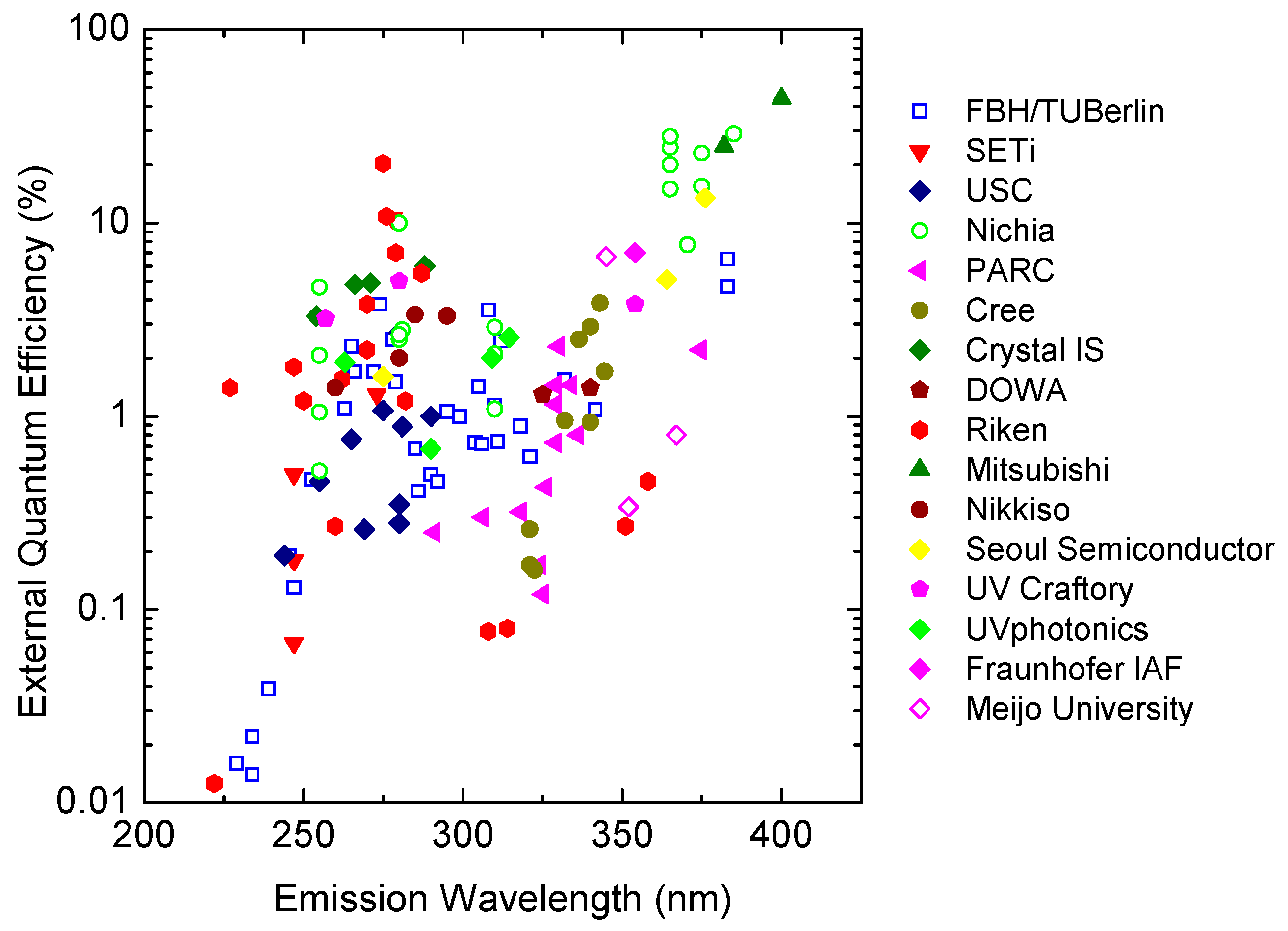
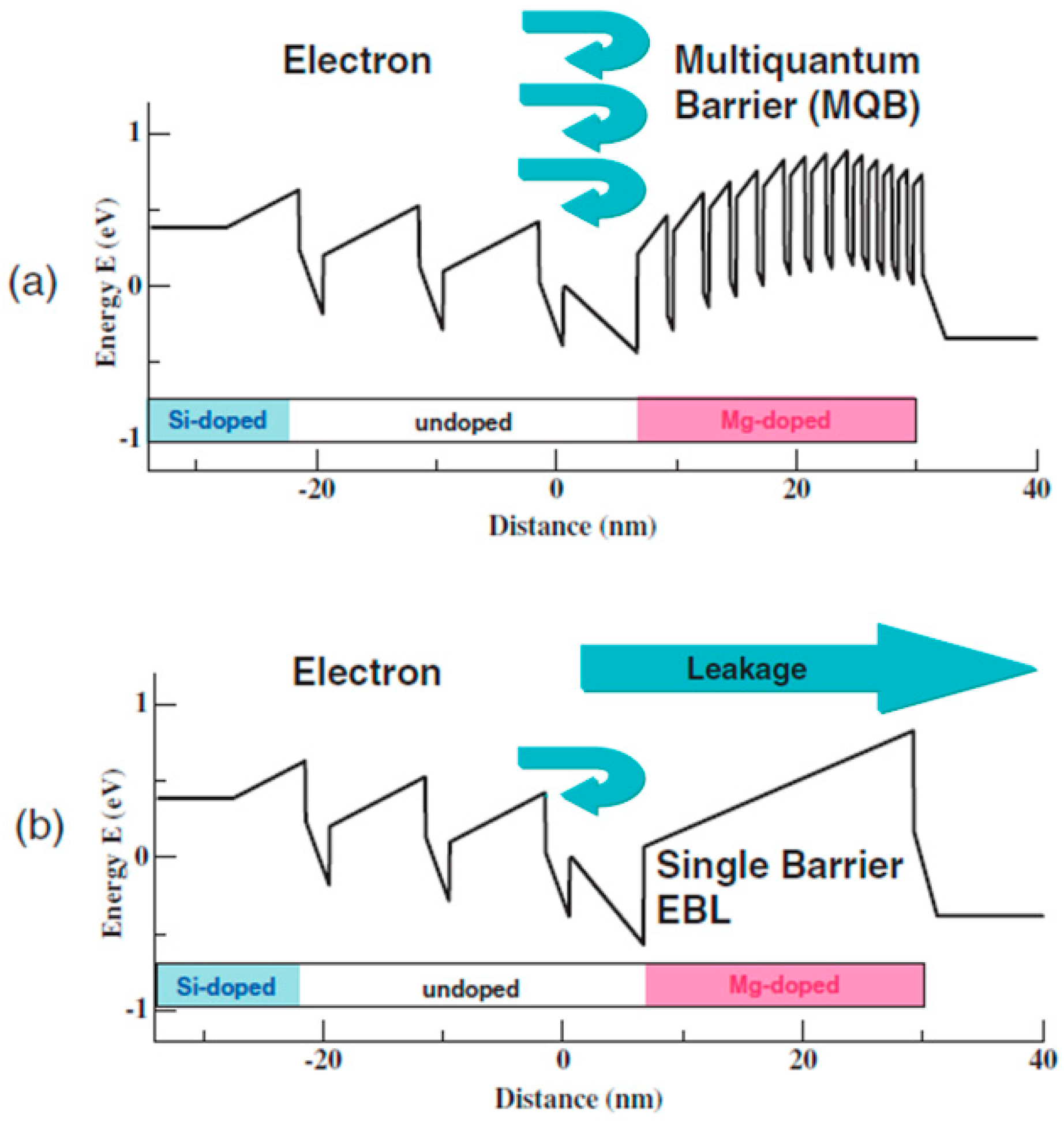
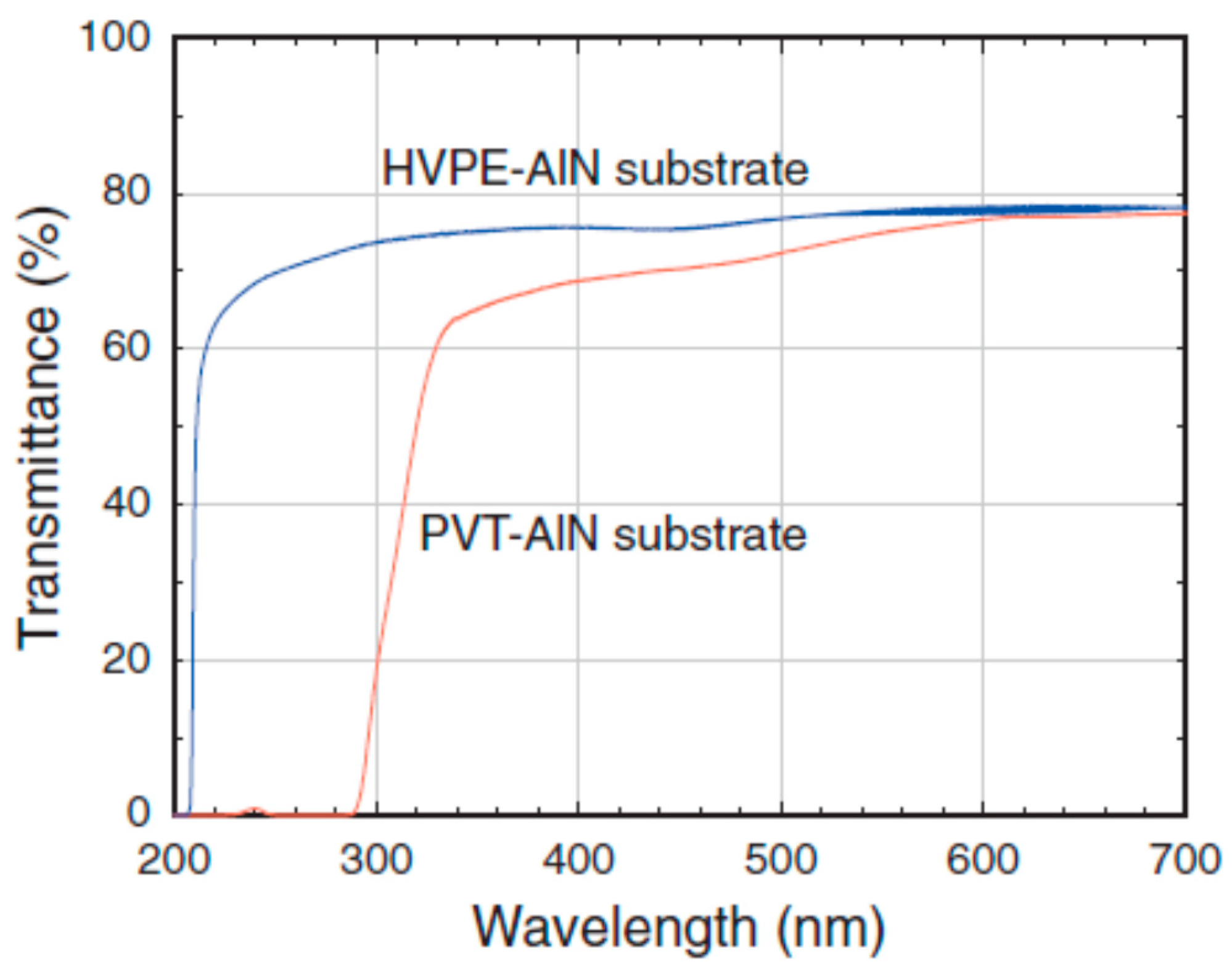

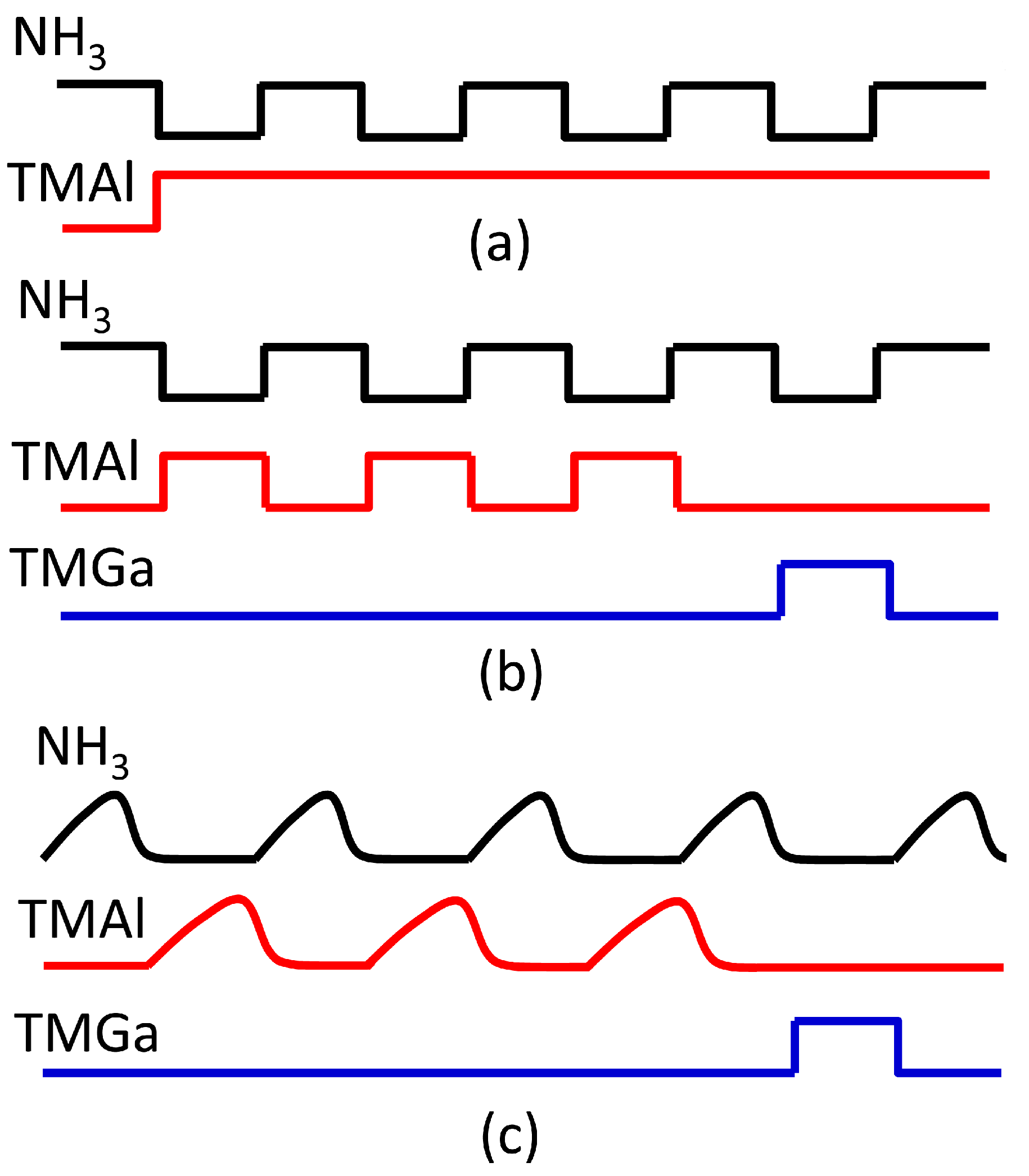

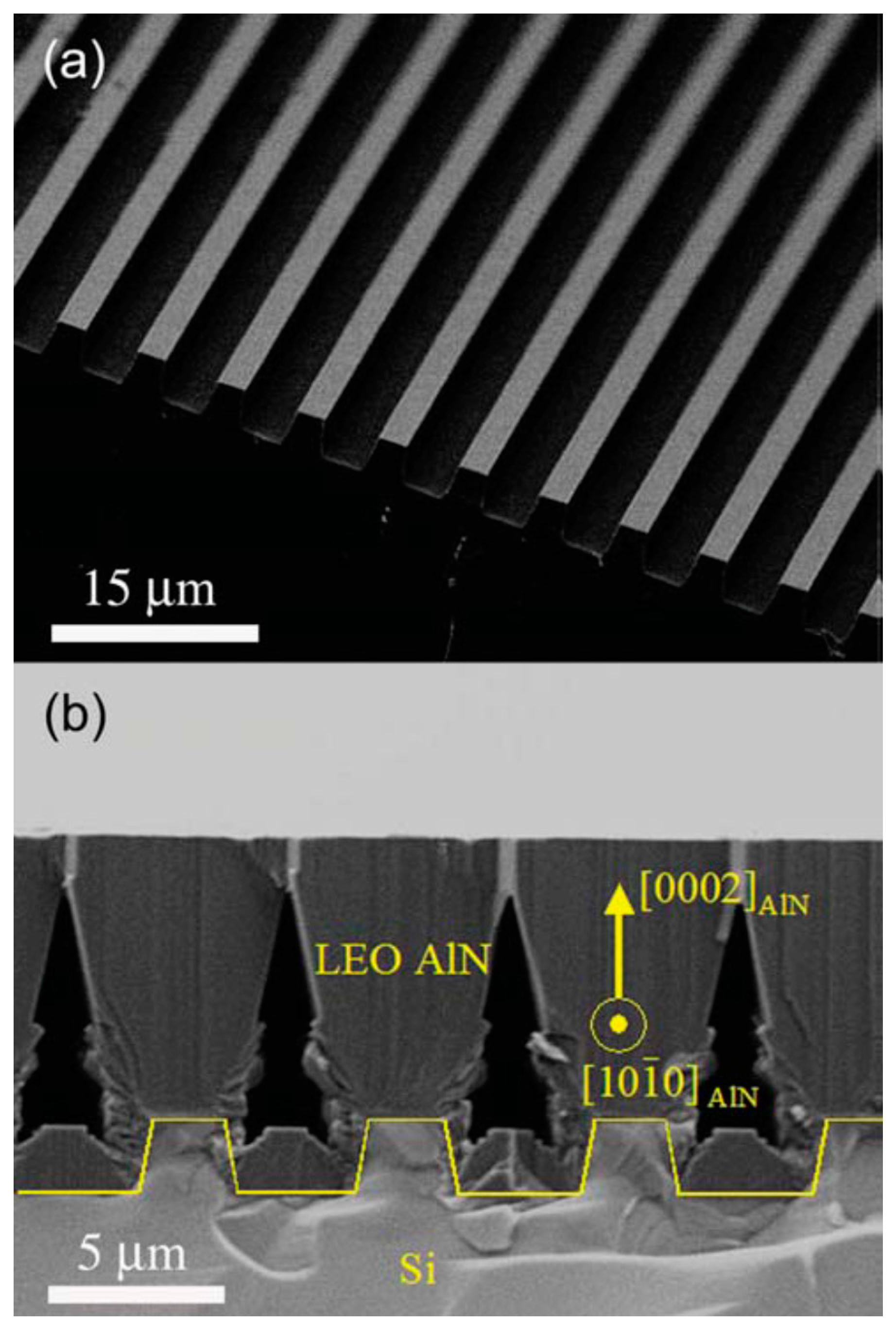
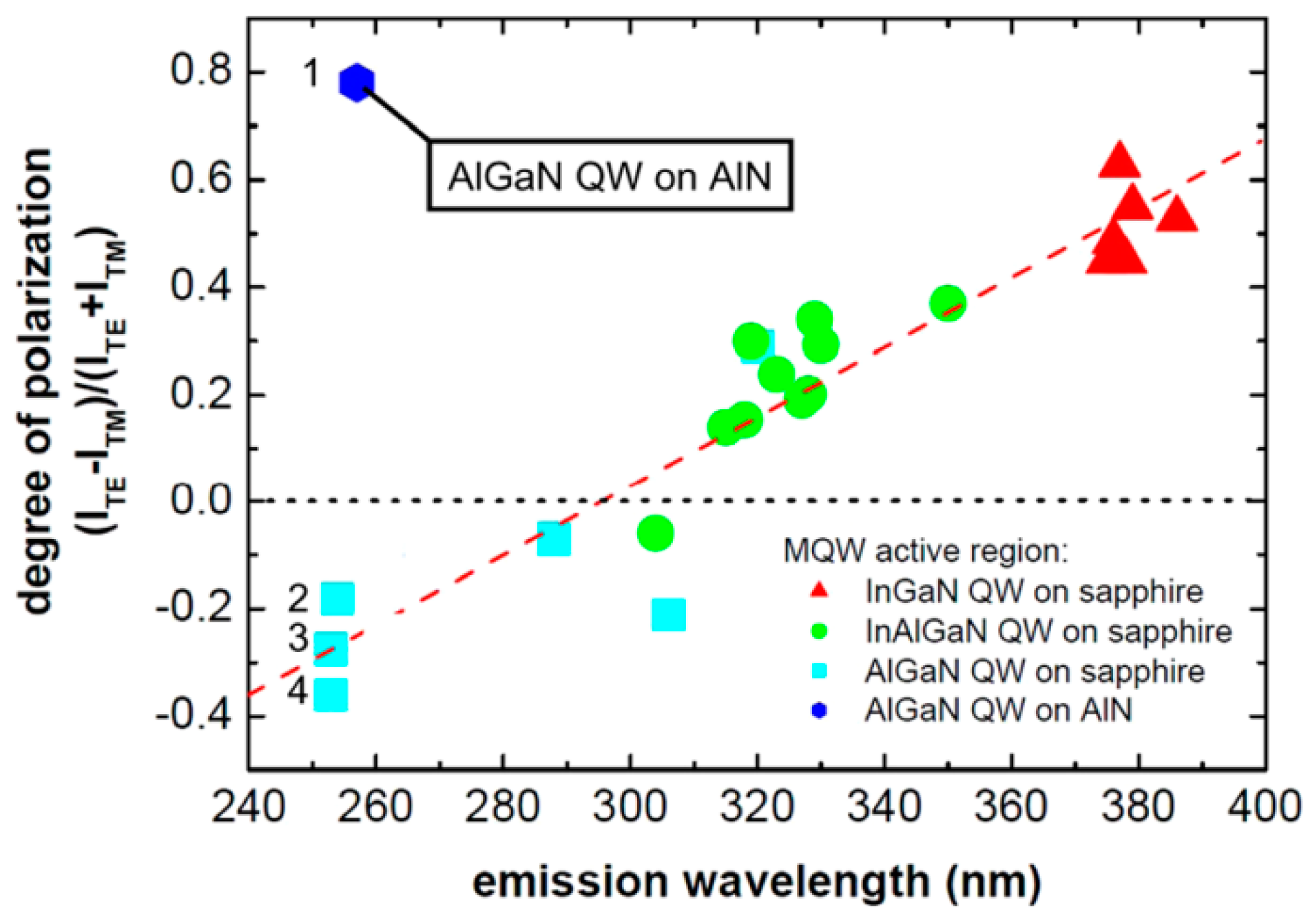

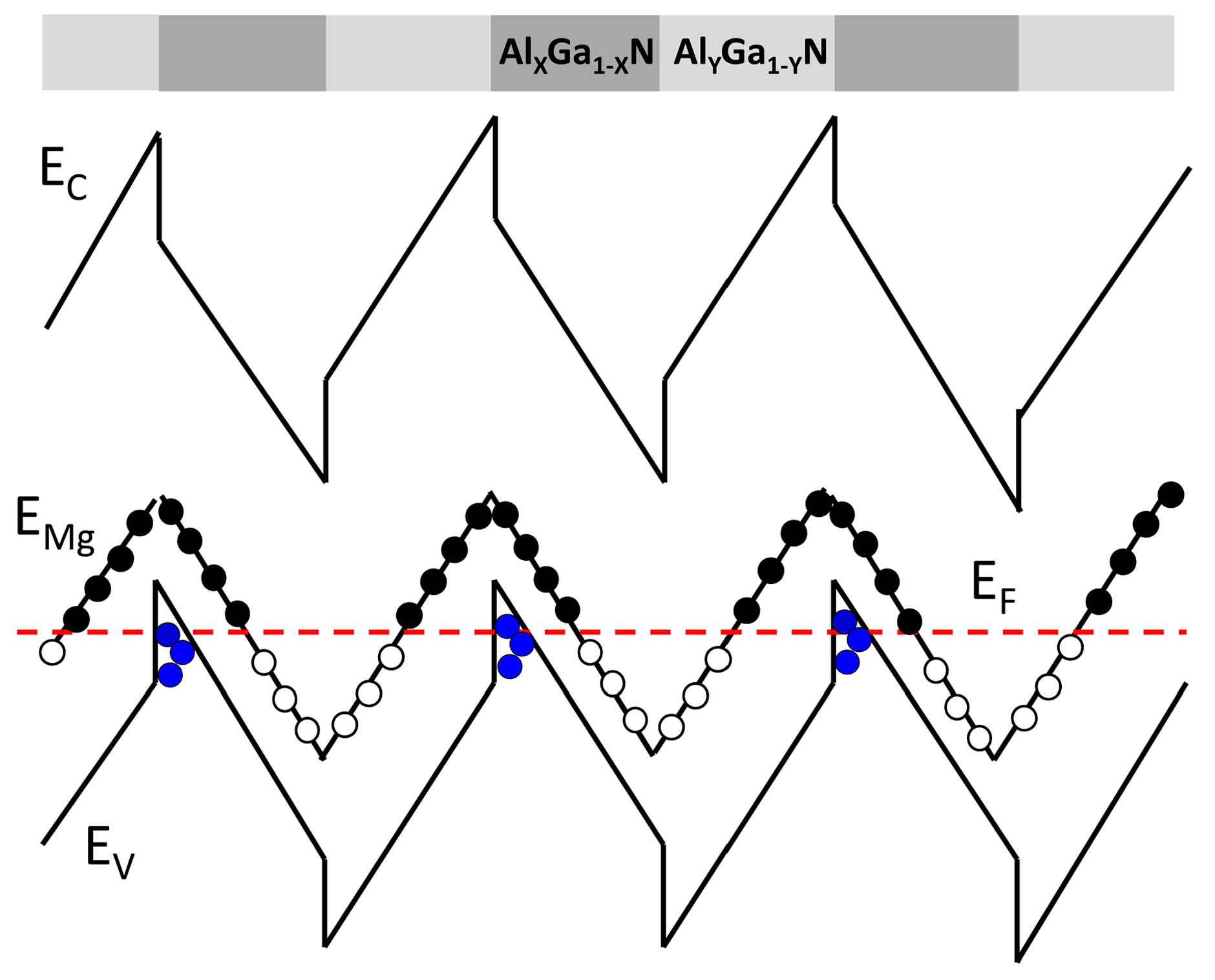
| Substrate | a-Axis (Å) | c-Axis Å | Mismatch to GaN | Mismatch to AlN | Thermal conductivity (W/cm K) | UV transparency | Availability | Price |
|---|---|---|---|---|---|---|---|---|
| Sapphire | 4.765 | 12.982 | 16.1% | 13.3% | 0.23 | √√ | √√ | √√ |
| Si (111) | 3.840 | 3.136 | 17% | 19% | 1.6 | X | √√ | √√ |
| 6H-SiC | 3.073 | 15.117 | 3.8% | 1.3% | 4.9 | X | √ | X |
| 4H-SiC | 3.076 | 10.053 | 3.7% | 1.2% | 3.7 | X | √ | X |
| GaN | 3.189 | 5.186 | 0% | 2.4% | 3.2 | X | X | XX |
| AlN | 3.112 | 4.982 | 2.5% | 0% | 2.1 | √ | XX | XXX |
© 2017 by the authors. Licensee MDPI, Basel, Switzerland. This article is an open access article distributed under the terms and conditions of the Creative Commons Attribution (CC BY) license (http://creativecommons.org/licenses/by/4.0/).
Share and Cite
Ding, K.; Avrutin, V.; Özgür, Ü.; Morkoç, H. Status of Growth of Group III-Nitride Heterostructures for Deep Ultraviolet Light-Emitting Diodes. Crystals 2017, 7, 300. https://doi.org/10.3390/cryst7100300
Ding K, Avrutin V, Özgür Ü, Morkoç H. Status of Growth of Group III-Nitride Heterostructures for Deep Ultraviolet Light-Emitting Diodes. Crystals. 2017; 7(10):300. https://doi.org/10.3390/cryst7100300
Chicago/Turabian StyleDing, Kai, Vitaliy Avrutin, Ümit Özgür, and Hadis Morkoç. 2017. "Status of Growth of Group III-Nitride Heterostructures for Deep Ultraviolet Light-Emitting Diodes" Crystals 7, no. 10: 300. https://doi.org/10.3390/cryst7100300
APA StyleDing, K., Avrutin, V., Özgür, Ü., & Morkoç, H. (2017). Status of Growth of Group III-Nitride Heterostructures for Deep Ultraviolet Light-Emitting Diodes. Crystals, 7(10), 300. https://doi.org/10.3390/cryst7100300







